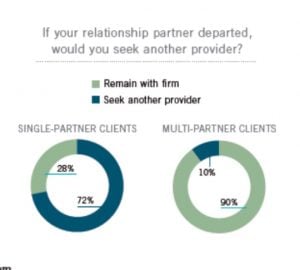How Smart Succession Planning Can Separate a Law Firm
No longer can firms bury their heads in the sand, hoping that succession planning will sort itself out.
May 21, 2019 at 02:00 PM
8 minute read

Many of the largest and most profitable firms today have been built on the backs of entrepreneurial lawyers who prospered within a live-and-let-live culture that rewarded them handsomely for winning top client business. Those lawyers—often thriving on a sort of maverick persona—served as sole relationship partners for their clients, which typically accounted for a sizeable portion of the firm's overall revenue. In recent years, though, as client problems have grown increasingly complex and multifaceted, the client service model has evolved from disaggregated, solo gurus to broader, cross-practice teams. Many firms are unprepared for this shift, as senior partners inch toward retirement with no real client succession plan in place.
Clients care deeply about succession planning–whether or not they reveal it directly to their client relationship partner. Clients increasingly demand direct access to the right experts to help solve tough business problems by leveraging insights from across other clients and industries. This form of integrated client service that incorporates multiple generations and a layering of expertise is what has been referred to as smart collaboration. It is instrumental in helping clients achieve a continuity of service, even when the senior partner moves on.
- Ensures continuity. It is common to find that over half of a firm's revenue is generated from clients whose relationships are managed or controlled by partners who are at least 60 years old. (Have you even analyzed your data this way?) This concentration of the firm's financial livelihood in the hands of senior partners poses substantial risk to firms if relationships aren't expanded to other partners and smoothly transitioned to successors.
- Offers superior client service. The major driver for law firms to develop a succession plan is client demand for superior service. Clients expect their firms to be forward-thinking, collaborative and innovative when it comes to tackling their business problems. This level of service requires a pipeline of talented lawyers who understand clients' specific issues and people—often from multiple perspectives. Establishing and articulating a sound succession plan sends a clear message to clients that the firm is looking to its future, putting the building blocks in place to adapt to changes, meet the needs of clients, transition relationships and continue its legacy.
 Creates stickier clients. Beyond better client service, strategic succession management ultimately creates longer-lasting client relationships. Client loyalty is already under considerable strain in the face of greater pressure for operational efficiency and innovation. Senior rainmakers and relationship partners need to develop a pipeline to understand and satisfy the changing demands of next-generation clients. Our research reveals that when clients are served by a single partner, 72% say they'd consider moving their business to a competitor if their relationship partner departed. In contrast, for those served by multiple partners, the proportion of at-risk clients drops to a mere 10%. This finding may strike you as common sense. But when we analyze many firms' portfolios, we find that a typical law firm has 75% of its client portfolio served by a single partner. Again, have you run the numbers in your firm?
Creates stickier clients. Beyond better client service, strategic succession management ultimately creates longer-lasting client relationships. Client loyalty is already under considerable strain in the face of greater pressure for operational efficiency and innovation. Senior rainmakers and relationship partners need to develop a pipeline to understand and satisfy the changing demands of next-generation clients. Our research reveals that when clients are served by a single partner, 72% say they'd consider moving their business to a competitor if their relationship partner departed. In contrast, for those served by multiple partners, the proportion of at-risk clients drops to a mere 10%. This finding may strike you as common sense. But when we analyze many firms' portfolios, we find that a typical law firm has 75% of its client portfolio served by a single partner. Again, have you run the numbers in your firm?- Offers young partners and exceptional talent room to grow. Too many firms are top heavy, with senior partners hoarding work and reluctant to share access to their client relationships. Frustrated millennials and young partners are more likely to leave their firm when they hit an impenetrable glass ceiling. So, by putting a succession plan in place, firms are better able to engage and retain up-and-coming talent by giving them space to grow professionally. Plus,younger people's expertise, which may be closer to the client's own customer base.
Challenges to Overcome
- Too big to tackle. Succession planning can be tricky to implement as firms struggle to effectively address client transition. The ancillary issues surrounding succession are significant, overwhelming and (for transitioning partners) emotional. The real obstacle is how to strategically execute since firms often struggle with decision paralysis and inaction.
- Fear, anxiety and identity crisis. Given how much time lawyers spend on their career, their identities are closely tied to their professional success—often with little room or desire to pursue other interests. Consequently, experienced partners fearfully guard their client relationships, which served as a foundation for their professional achievement. Many resist giving away their hard-earned clients, particularly to juniors who, in their minds, expect such opportunities without having to do the hard work of finding and landing new clients. These complicated and sensitive dynamics can wreak havoc at all levels of the firm if not carefully managed.
- Culture and compensation systems. Firm cultures and profits now rely heavily on stars. In many firms, compensation models encourage and reward control over client relationships by top partners on the accounts – while others are not rewarded for nurturing and expanding client relationships. This focus on individual stars at the expense of collaboration results in partners lacking confidence in their firm's future, affinity to the collective values, or a strong commitment to assuring their firm's legacy into the next generation.
Start Soon
By addressing succession management as part of the natural talent life cycle as soon as lawyers advance to the partnership, client transitions simply become part of how the firm manages its business. This approach helps partners focus on the future upside, which runs counter to typical human psychology. Daniel Kahneman, a Nobel Prize-winning behavioral economist, developed prospect theory, which shows that people pay more attention to losses than gains. This helps to explain why firms need to help partners reframe and destigmatize their upcoming retirement: from “giving up control” to “building a legacy.”
Putting a retirement plan in place encourages partners to actually retire. As one former Am Law 25 partner said, “When I turned 60 and was looking forward to becoming a director at a major philanthropy, life after Big Law felt like less of an identity assault.”
Much to many lawyers' surprise, though, those other roles take much longer to develop than they expect—and lawyers' skills aren't the ones most in demand by boards these days. A recent survey of 5,000 corporate directors published in the Harvard Business Review showed that 69% believe they're already above average or excellent at compliance, the area among the respondents' 15 top strategic challenges where lawyers might be best placed to assist.
One experienced corporate non-executive director who has served on multiple boards' search committees said that even lawyers who have had significant board-level exposure often over-estimate their potential value as directors because they lack large-scale, hands-on operational experience. Her experience suggests that the most attractive ex-lawyer candidates are those who invest at least five years after leaving their partnership to build managerial and leadership skills, for example in a private equity firm. All this evidence points to the need for firms to equip their partners with perspective and options, starting with some early planning.
One example comes from White & Case, which instituted an innovative program to proactively address its partners' transitions. Starting five years before a partner reaches typical retirement age, the firm begins a series of formal, annual conversations with every partner to discuss their professional expectations for the coming years. This dialogue not only prompts the necessary self-reflection, but also allows the individual to start taking steps toward reaching his or her objectives.
Furthermore, knowledge of the partner's intentions helps White & Case to plan for how to transition client work smoothly, effectively and proactively. White & Case has also created a client council, with senior partners acting as an advisory board for lead client partners.
According to White & Case's chairman, Hugh Verrier:
The client council is not just authorizing the lead partners to build and broaden the team serving the clients. It acts also as a mechanism to monitor and help. The members give the benefit of experience, thoughts, advice. And, to give the process some teeth, the council also gives input on compensation for the lead partners.
If the council notices succession issues within the key client program, it intervenes to guide the transition. It actually has the power to change the lead partners, although this option has rarely been used. Instead, the council works with the lead client partners to encourage them to promote a proactive, smooth succession. Although still in its early stages, the program has so far been successful by combining advice and accountability.
Next Steps
No longer can firms bury their heads in the sand, hoping that succession planning will sort itself out without firmwide interventions. The evidence is clear: Firms that prioritize their succession management strategy set the stage for long-term prosperity for all generations of lawyers, their clients, and the firm itself. The second article in our two-part series will feature 10 nuts-and-bolts steps for firms eager to get started on revamping their client succession approach.
Heidi K. Gardner, PhD, is a distinguished fellow at Harvard Law School's Center on the Legal Profession and co-founder of Gardner & Co. advisory firm. She can be reached at [email protected]
Susan Saltonstall Duncan is the president of RainMaking Oasis LLC, a management consulting firm to law firms. She can be reached at [email protected].
This content has been archived. It is available through our partners, LexisNexis® and Bloomberg Law.
To view this content, please continue to their sites.
Not a Lexis Subscriber?
Subscribe Now
Not a Bloomberg Law Subscriber?
Subscribe Now
NOT FOR REPRINT
© 2025 ALM Global, LLC, All Rights Reserved. Request academic re-use from www.copyright.com. All other uses, submit a request to [email protected]. For more information visit Asset & Logo Licensing.
You Might Like
View All

Three Akin Sports Lawyers Jump to Employment Firm Littler Mendelson

Brownstein Adds Former Interior Secretary, Offering 'Strategic Counsel' During New Trump Term
2 minute read
Trending Stories
- 1Silk Road Founder Ross Ulbricht Has New York Sentence Pardoned by Trump
- 2Settlement Allows Spouses of U.S. Citizens to Reopen Removal Proceedings
- 3CFPB Resolves Flurry of Enforcement Actions in Biden's Final Week
- 4Judge Orders SoCal Edison to Preserve Evidence Relating to Los Angeles Wildfires
- 5Legal Community Luminaries Honored at New York State Bar Association’s Annual Meeting
Who Got The Work
J. Brugh Lower of Gibbons has entered an appearance for industrial equipment supplier Devco Corporation in a pending trademark infringement lawsuit. The suit, accusing the defendant of selling knock-off Graco products, was filed Dec. 18 in New Jersey District Court by Rivkin Radler on behalf of Graco Inc. and Graco Minnesota. The case, assigned to U.S. District Judge Zahid N. Quraishi, is 3:24-cv-11294, Graco Inc. et al v. Devco Corporation.
Who Got The Work
Rebecca Maller-Stein and Kent A. Yalowitz of Arnold & Porter Kaye Scholer have entered their appearances for Hanaco Venture Capital and its executives, Lior Prosor and David Frankel, in a pending securities lawsuit. The action, filed on Dec. 24 in New York Southern District Court by Zell, Aron & Co. on behalf of Goldeneye Advisors, accuses the defendants of negligently and fraudulently managing the plaintiff's $1 million investment. The case, assigned to U.S. District Judge Vernon S. Broderick, is 1:24-cv-09918, Goldeneye Advisors, LLC v. Hanaco Venture Capital, Ltd. et al.
Who Got The Work
Attorneys from A&O Shearman has stepped in as defense counsel for Toronto-Dominion Bank and other defendants in a pending securities class action. The suit, filed Dec. 11 in New York Southern District Court by Bleichmar Fonti & Auld, accuses the defendants of concealing the bank's 'pervasive' deficiencies in regards to its compliance with the Bank Secrecy Act and the quality of its anti-money laundering controls. The case, assigned to U.S. District Judge Arun Subramanian, is 1:24-cv-09445, Gonzalez v. The Toronto-Dominion Bank et al.
Who Got The Work
Crown Castle International, a Pennsylvania company providing shared communications infrastructure, has turned to Luke D. Wolf of Gordon Rees Scully Mansukhani to fend off a pending breach-of-contract lawsuit. The court action, filed Nov. 25 in Michigan Eastern District Court by Hooper Hathaway PC on behalf of The Town Residences LLC, accuses Crown Castle of failing to transfer approximately $30,000 in utility payments from T-Mobile in breach of a roof-top lease and assignment agreement. The case, assigned to U.S. District Judge Susan K. Declercq, is 2:24-cv-13131, The Town Residences LLC v. T-Mobile US, Inc. et al.
Who Got The Work
Wilfred P. Coronato and Daniel M. Schwartz of McCarter & English have stepped in as defense counsel to Electrolux Home Products Inc. in a pending product liability lawsuit. The court action, filed Nov. 26 in New York Eastern District Court by Poulos Lopiccolo PC and Nagel Rice LLP on behalf of David Stern, alleges that the defendant's refrigerators’ drawers and shelving repeatedly break and fall apart within months after purchase. The case, assigned to U.S. District Judge Joan M. Azrack, is 2:24-cv-08204, Stern v. Electrolux Home Products, Inc.
Featured Firms
Law Offices of Gary Martin Hays & Associates, P.C.
(470) 294-1674
Law Offices of Mark E. Salomone
(857) 444-6468
Smith & Hassler
(713) 739-1250









